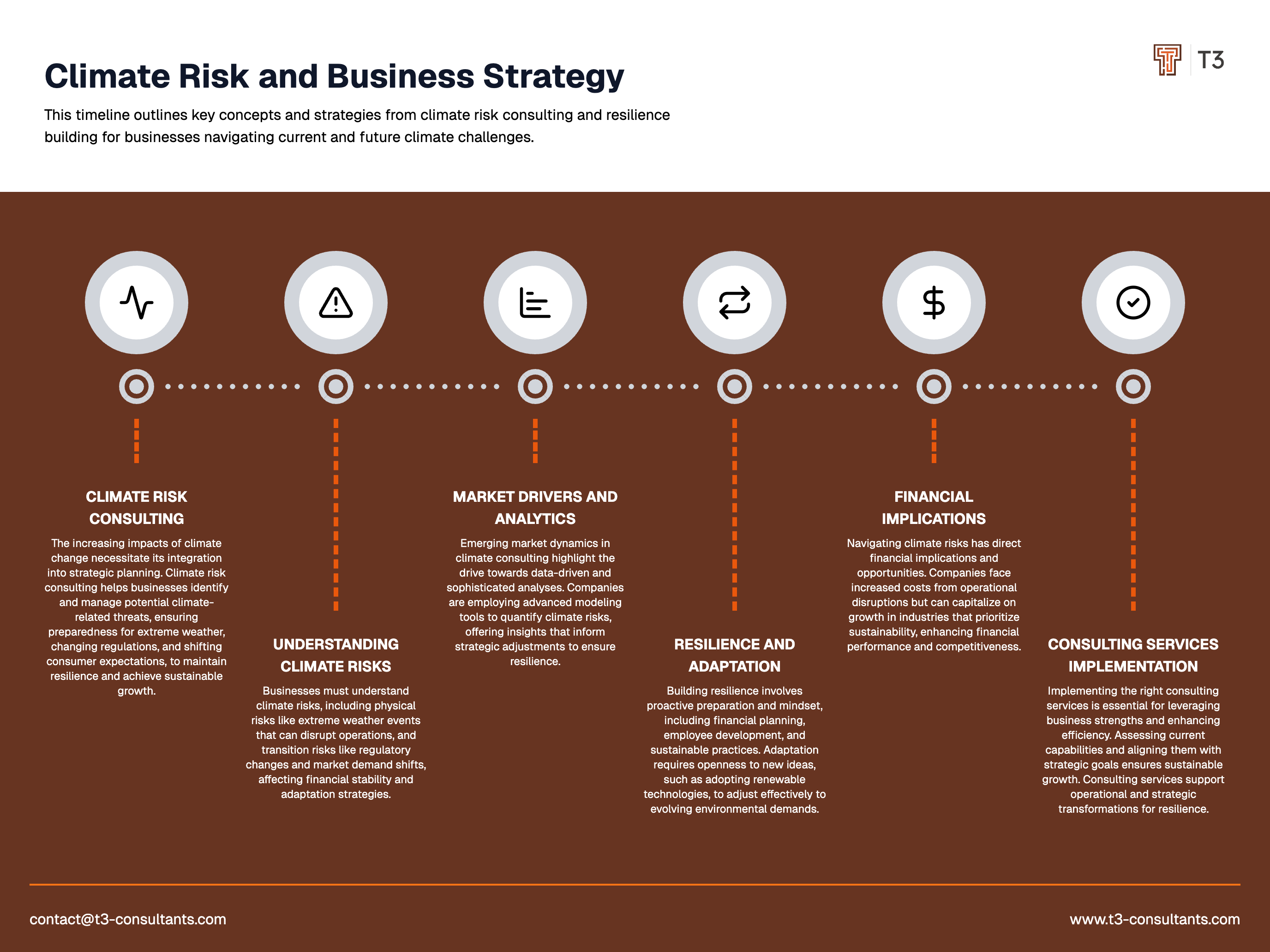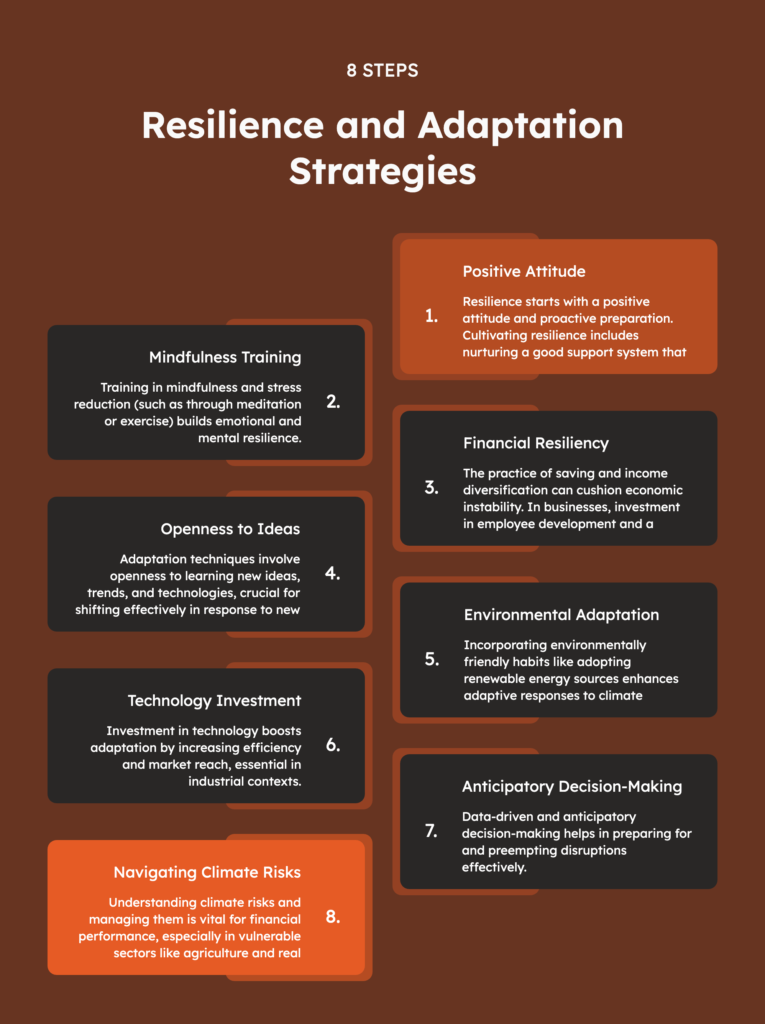
Climate Risk Consulting: Essential for Future Planning
Climate risk consulting has become a key part of strategic future planning for businesses and governments, and for good reason. The impacts of climate change are becoming more apparent, and the integration of climate risk assessments in strategic decision-making processes is increasingly necessary. This involves understanding the possible threats posed by climate change and how it could affect operations, infrastructure, and supply chains.
Expert climate risk consulting helps organizations to identify potential weaknesses and devise strong strategies for effectively managing those risks. By taking such a proactive approach, companies can ensure that they are prepared to deal with challenges like extreme weather conditions, the rapidly changing regulatory environment, and ever-more demanding customers. By utilizing climate risk consulting, companies can protect their assets and improve their resilience, enabling sustainable growth in an uncertain future. Ultimately, including climate science in decision-making processes provides a competitive edge.
What are Climate Risks?
In today’s world of rapid change, an understanding of climate risks is essential for any business or organization committed to long-term resilience and sustainability. Climate risks refer to the potential adverse impacts of climate change on economic activities, human health, and the environment. These risks generally fall into two broad categories: physical risks and transition risks.
- Physical climate risks: The direct impacts of climate change on the natural environment. This includes more frequent and severe extreme weather events (storms, floods, hurricanes, wildfires, droughts). These events can disrupt supply chains, damage infrastructure, and reduce agricultural productivity, all of which can lead to financial loss and business interruption.
- Transition risks: Risks that arise as the world transitions to a low-carbon economy. New regulations by governments to combat climate change might impose higher costs on companies in order to comply, and encourage the adoption of low-carbon technology. A shift towards sustainable practices also poses risks associated with shifts in market demand and consumer behaviour, meaning firms slow to adapt are likely to be left behind.
The impact of these is material for businesses and organizations. Physical risks can lead to costly damage and legal claims, impacting the bottom line. For example, industries which depend on natural resources may face shortages and cost increases. Transition risks can impact investment strategies and financial stability, as businesses redirect investments to meet renewable energy targets and net-zero carbon goals.
Having a grasp of these risks is critical to developing an effective risk management strategy. By addressing the implications of both types of risk, companies will be better prepared for a sustainable future, where business operations and investments are resilient to evolving climate and market conditions. Doing so not only helps to protect against losses but can unlock opportunities in the green economy.
Market Drivers in Climate Risk Consulting
In the last few years, there has been a sharp increase in the demand for climate risk consulting. It has emerged as a key component of corporate strategic planning across industries. The fast-growing market is being driven by a growing recognition of climate risks and a slew of regulatory requirements, which are forcing companies to embed climate resilience in their strategies.
Current market drivers in climate risk consulting are pointing toward a pivot to more thorough and data-driven analyses. Companies are starting to leverage sophisticated modeling tools to quantify climate risks and to consider how such risks may affect their business operations and supply chains. Aon’s sophisticated risk assessment models and capabilities offer their clients unparalleled insights to help them manage financial and operational exposures associated with climate change.
Another key player and market entrant in the industry like Aon is Anthesis, which provides bespoke sustainability and climate risk solutions. Anthesis has been known for creative techniques that intertwine environmental science knowledge with pragmatic business acumen, helping firms to advance companionably with newly emerging regulatory changes and investor demands.
Moreover, the synergies between the public and private sectors are increasing the efficiency of climate risk consulting. They are uniting to standardize risk assessment methodologies and to boost transparency in the disclosure of climate risks that empower stakeholders to make informed decisions.
The ever-changing climate risk consulting services attest to a growing marketplace with multiple prospects. They are essential as more businesses start emphasizing sustainability. These top climate consultants such as Aon and Anthesis will be more crucial in providing imperative advice to mold resilient and future-ready business strategies. Through taking account of these market dynamics, it will not only protect companies against threats to growth but also boost taking care of the environment globally.
Strategies for Resilience and Adaptation
Developing effective strategies for resilience and adaptation in a rapidly changing world is increasingly important for individuals, organizations, and communities. Resilience (the ability to endure and recover from hardship) and adaptation (adjusting to new circumstances) are two pillars of enduring growth and achievement.
Strategies for Resilience
Resilience starts with a positive attitude and proactive preparation. Cultivating resilience includes nurturing a good support system that supplies both emotional support in times of trouble and operational aid during times of crisis. Training in mindfulness and stress reduction (such as through meditation or exercise) builds emotional and mental muscles. Setting achievable, incremental objectives can help prevent becoming overwhelmed and instead create a pattern of achievement and development.
Financial resiliency is another key element in resilience. The practice of saving and the process of generating income diversification can cushion economic instability. In a business setting, resilience can be fostered by investment in employee development, a flexible organizational framework, and forward-thinking solutions that anticipate change rather than merely reacting to it.
Adaptation Techniques
Adaptation techniques are equally important, as they describe how effectively individuals or groups can shift in response to a new challenge. Openness to new ideas involves an awareness of new trends and technologies as well as a predisposition to learn or unlearn frameworks. Adaptive flexibility provides a set of novel, contextually appropriate solutions to a given situation.
In environmental terms, adaptation could mean embracing environmentally friendly habits (e.g. adopting renewable energy sources, enhancing ecosystem infrastructure to better handle climate change effects). In an industrial context, the emphasis on adaptation often lies in technology investment, deploying technology to increase efficiency and reach a wider customer base.
Data-driven, anticipatory decision-making can better prepare for and preempt disruption. Collectively, fostering resilience and adaptation prepares individuals and organizations to tackle the unpredictable challenges of modern life.
Resilience and adaptation are ever-evolving competencies that require regular audit and update. By these dual prisms, individuals and organizations can not only survive but excel, turning setbacks into spaces for growth and fresh thinking.

Financial Implications and Opportunities: Navigating Climate Risks to Drive Profitable Ventures
Climate change has substantial financial consequences, affecting all industries worldwide through constraints on resources, changes in regulations, and shifts in consumer preferences. Adapting to and managing these consequences will be crucial for businesses in order to remain competitive and resilient. Any and all climate risks, from natural disasters to evolving market conditions, could present significant costs and/or revenue volatility, requiring careful financial management. The challenge for companies will be in how they can quantify and manage these risks to protect their financial performance.
One such financial implication to be considered from climate risk is the potential for increased operational costs. Specific sectors, such as agriculture, energy, and real estate, may be particularly vulnerable. This is likely to be seen in the form of increased insurance costs, resource constraints, or damage to property; leading organizations to better manage risks internally, and proactively adapt to these changing conditions. The deployment of sustainable infrastructure and technologies could mitigate these risks, thereby acting as a pre-emptive measure to protect financial performance and comply with changing regulatory requirements and consumer preferences.
Yet there are also lucrative opportunities presented by climate risk. Businesses who can identify, capture, and benefit from these financial opportunities will excel in a more volatile world. Growing markets, with the likes of renewable energy, sustainable transportation, or green construction, offer attractive options to multiply and diversify revenue streams. By investing in sustainable solutions and technologies, organizations will not only lessen their environmental impact but more importantly, soften the blow from potential future regulation or shifts in consumer appetite.
Meanwhile, robust risk management frameworks are essential in bolstering the reputation and reliability of a business, which could in turn attract capital or custom from increasingly sustainability-savvy investors and consumers. The identification of these opportunities requires strategic assessments of the market and agility in financial planning because as the global move toward sustainability becomes apparent, businesses that seize the initiative will not only ensure robustness and longevity but also competitiveness. Understanding how to navigate the financial implications generated by climate risk is the key to subscribing to sustainable future growth and to remaining competitive in the market.
Implementation and Services
Selecting the right services is critical in today’s competitive business environment. We offer a full spectrum of consulting services to help improve company performance, boost efficiencies, and build required management support systems. Our consultants are committed to providing practical, cost-effective solutions to help our clients achieve their strategic business objectives.
Choosing the right services depends on a number of factors today. A thorough assessment of current capabilities and future needs is an obvious first step, ensuring that any solution provided is designed to meet the current and projected objectives. This type of strategic input is where we begin our consulting service with you. The objective is to provide solutions that are linked to measurable goals and outcomes.
Our Management consulting is the core of our service, supporting organizations across all sectors to become more efficient and make solid, timely, and effective decisions. With a strong emphasis on innovation and best practices, as well as industry change, we help you tackle improvements and unlock the potential in your business.
To assist in a quick and easy selection of required services, we work with you in every step of the process. We begin with assessing your current and future needs and guide you to the strategy that will see you through the implementation. Our consulting services serve your needs well whatever your business objectives are, whether it involves efficiency in operations, developing required new capacities, taking products to market, or delivering services.
In summary, climate risk consulting is necessary to comprehend and address the significant threats to the environment and society. With increasing climate risks, it is important for organizations to look for expert assistance in ensuring a sustainable future. Planning ahead enables businesses and communities to foresee risks and plan on how to minimize damages. Through recognizing the interrelatedness of climate, risk, and effective solutions, stakeholders can make educated decisions that secure their future. Applying these methods builds resilience and a cleaner, more sustainable world for our children. Invest in climate risk consulting to manage an unstable future
